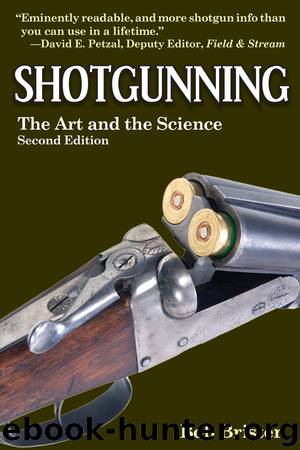Shotgunning by Brister Bob

Author:Brister, Bob
Language: eng
Format: epub
Publisher: Skyhorse Publishing
Published: 2014-01-01T05:00:00+00:00
Courtesy Winchester-Western
Effect of Wind on Shot Clouds (Nilo Shotshell Efficiency Test, 1972-73)
Courtesy Winchester-Western
Patterns are also affected by cold and by altitude. As any airplane pilot knows, cold air is dense and warm air is thin. The resistance and/or density of air is what opens up a shotgun pattern; if one could shoot test patterns in a vacuum, a cylinder bore should give full-choke performance.
Thus, patterns will tend to be more open, and penetrate less, in very cold weather.
Patterns will tend to be tighter, and penetrate farther at high altitude because they are encountering less atmospheric resistance.
A gun that throws modified patterns at sea level may throw full-choke patterns at Denver, Colorado, or Mexico City.
All of which should provide some wonderful alibis for missing game. But in providing these, I must take away one. Like most shooters I had always believed that a crosswind would greatly disrupt a pat tern, causing it to be full of holes. But according to Ed Lowry, this is not so much the case as might be assumed. “A crosswind does not disrupt a pattern in any way,” he wrote me, “it just moves it over.”
I cannot quarrel with a man of Lowry’s credentials, but I have tested a great many patterns in South Texas wind and found some lowering of efficiency, particularly with steel shot beyond 50 yards. But I indeed failed to find any donut holes or other old wives’ tales—and there goes another good excuse.
Download
This site does not store any files on its server. We only index and link to content provided by other sites. Please contact the content providers to delete copyright contents if any and email us, we'll remove relevant links or contents immediately.
Backpacker the Complete Guide to Backpacking by Backpacker Magazine(2193)
Capital in the Twenty-First Century by Thomas Piketty(1949)
The Isle of Mull by Terry Marsh(1898)
Predation ID Manual by Kurt Alt(1657)
The Collected Non-Fiction by George Orwell(1573)
Small-Bore Rifles by C. Rodney James(1504)
All Fishermen Are Liars by John Gierach(1445)
Backcountry Bear Basics by Dave Smith(1434)
Creative Confidence by Tom Kelley(1416)
The Art of Throwing by Amante P. Marinas Sr(1355)
50 Famous Firearms You've Got to Own by Rick Hacker(1341)
Archery: The Art of Repetition by Simon Needham(1303)
Blood Mountain by J.T. Warren(1303)
Long Distance Walking in Britain by Damian Hall(1279)
The Scouting Guide to Survival by The Boy Scouts of America(1251)
Backpacker Long Trails by Backpacker Magazine(1248)
The Fair Chase by Philip Dray(1225)
The Real Wolf by Ted B. Lyon & Will N. Graves(1212)
The Ultimate Guide to Home Butchering by Monte Burch(1204)
